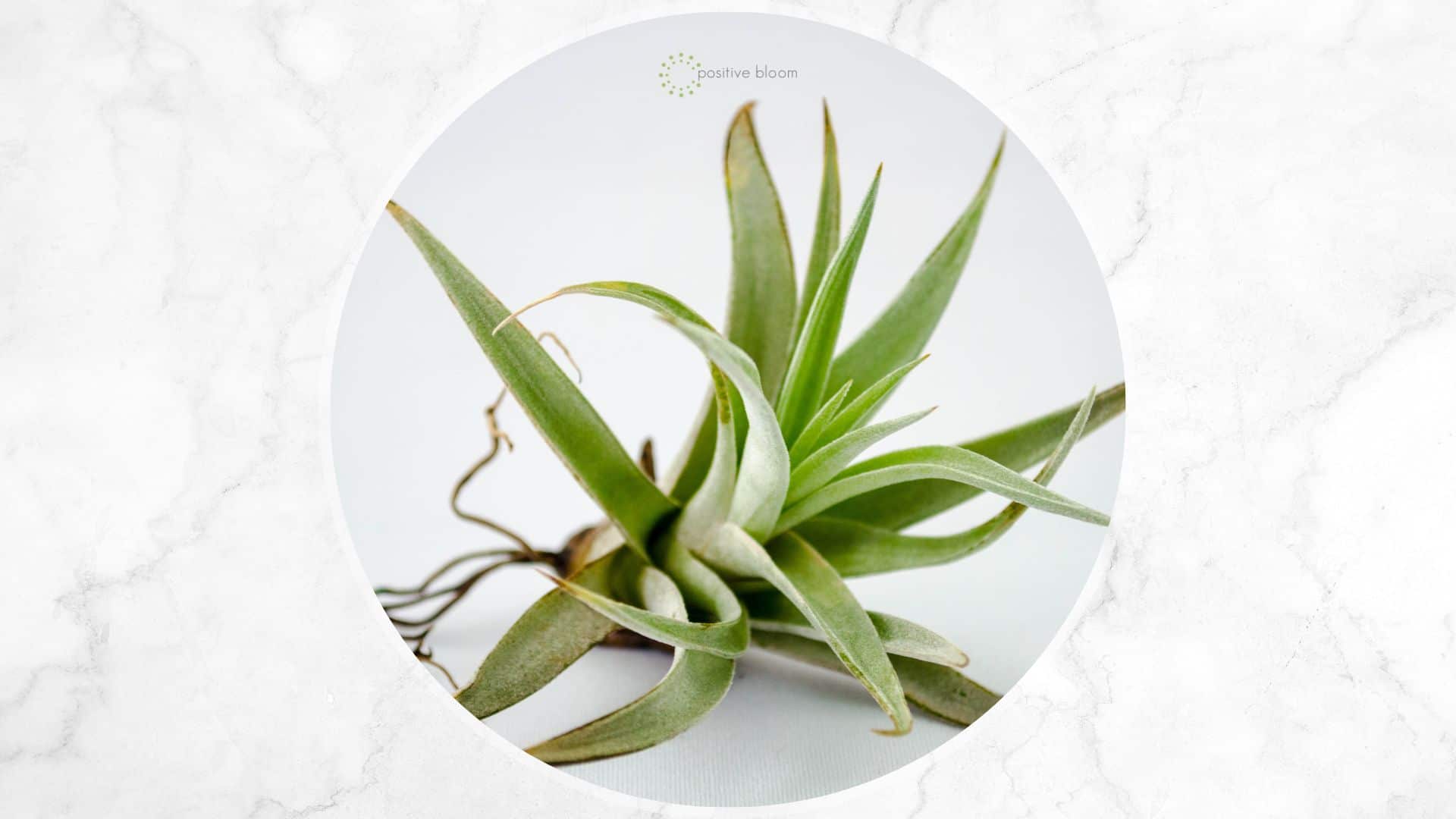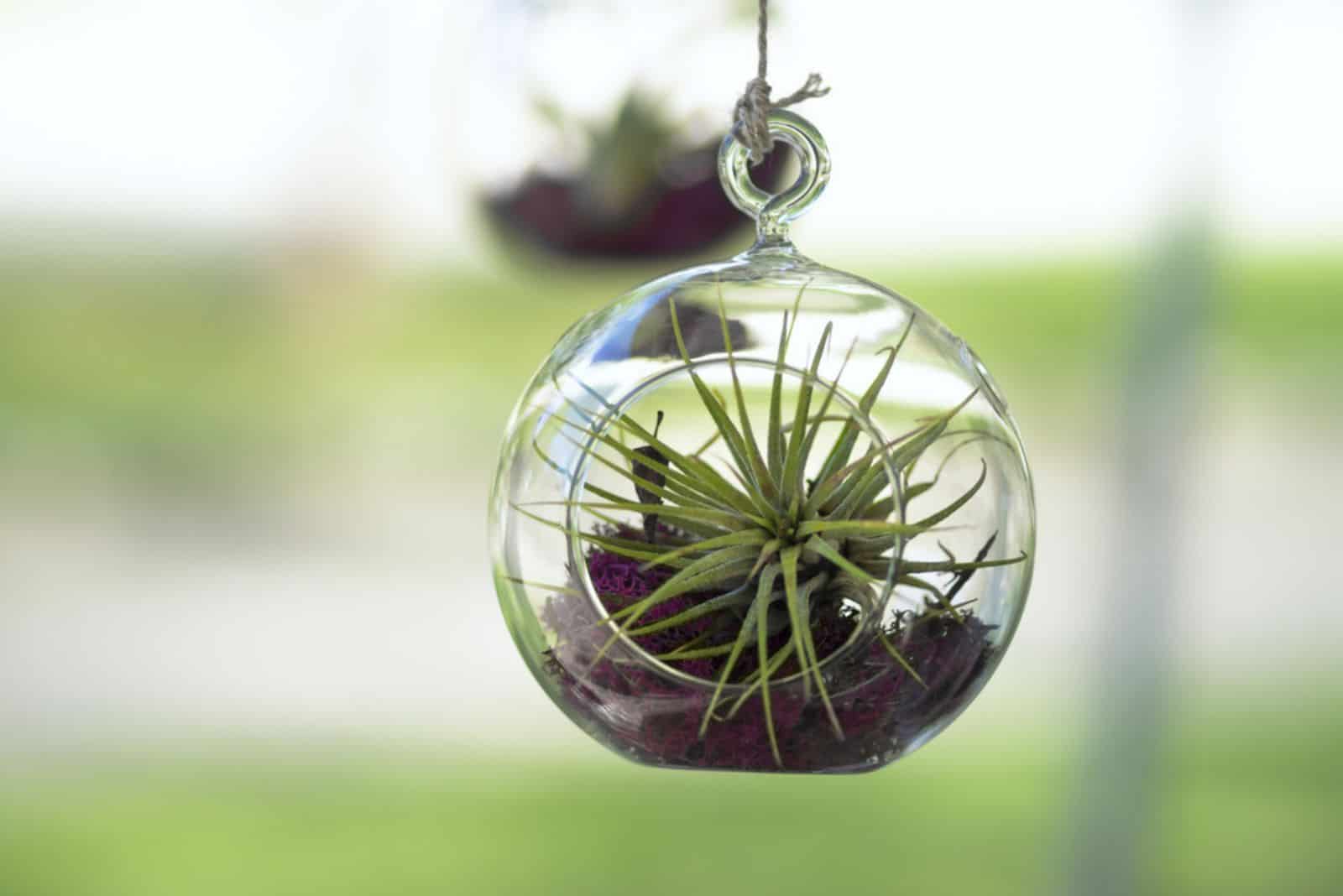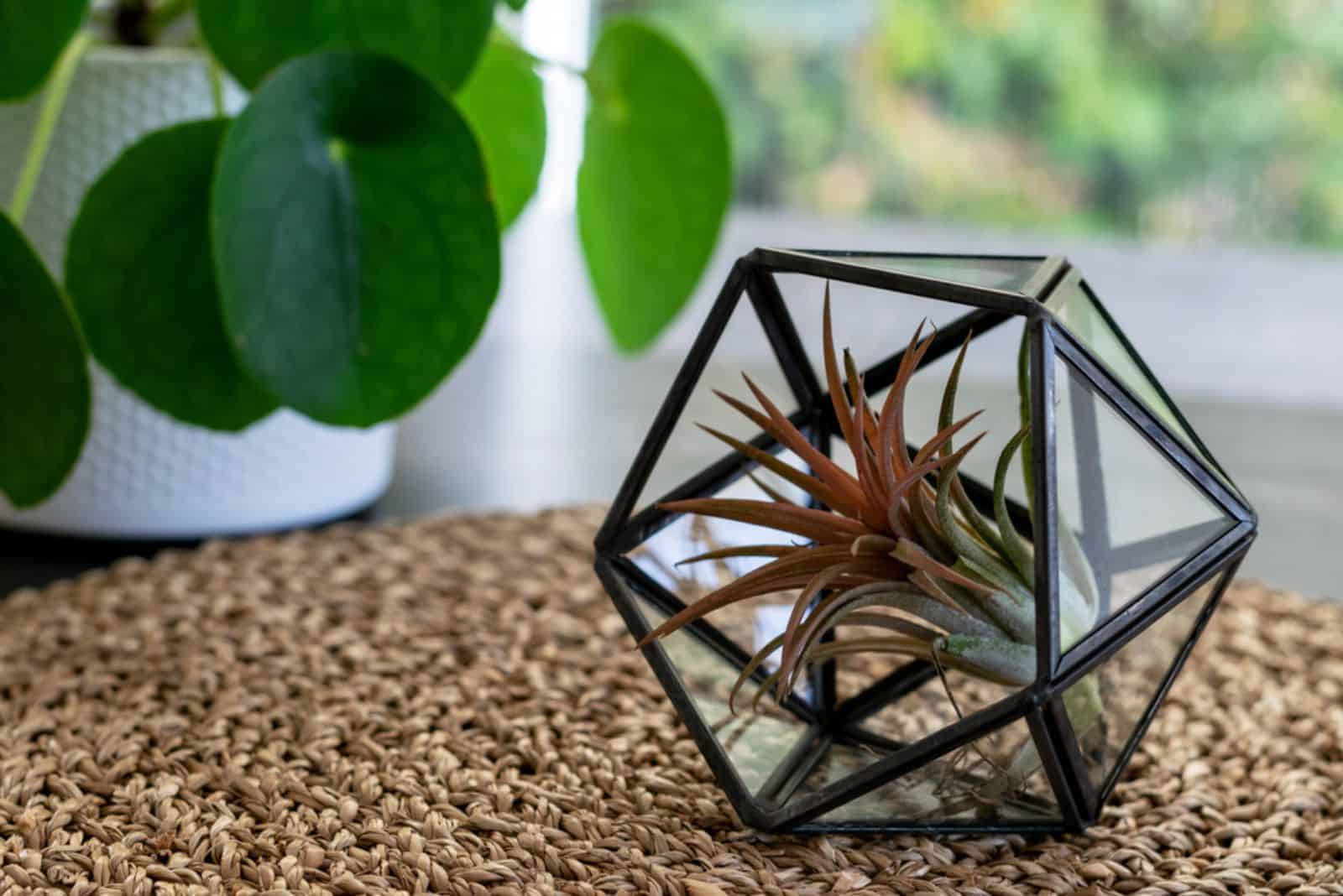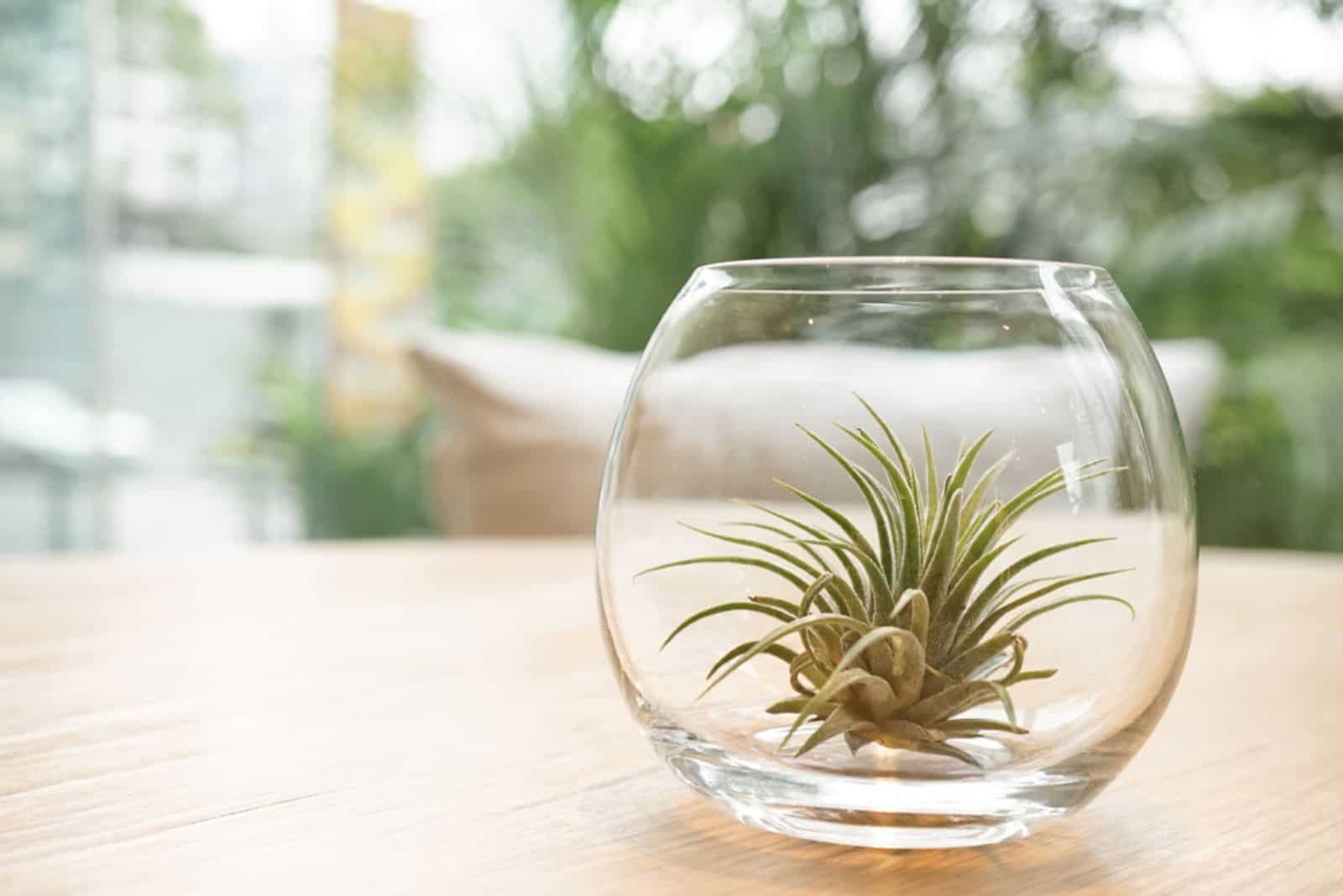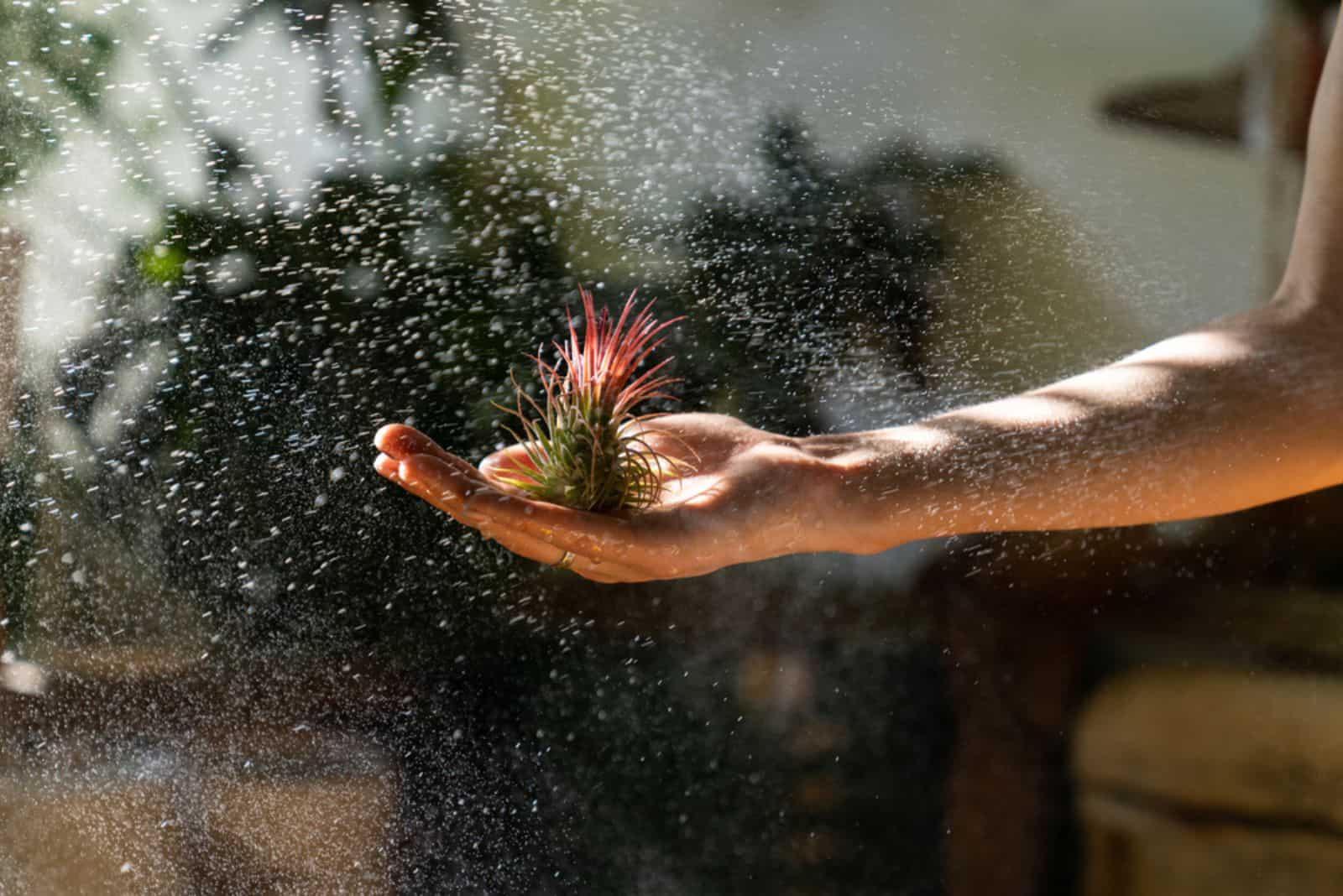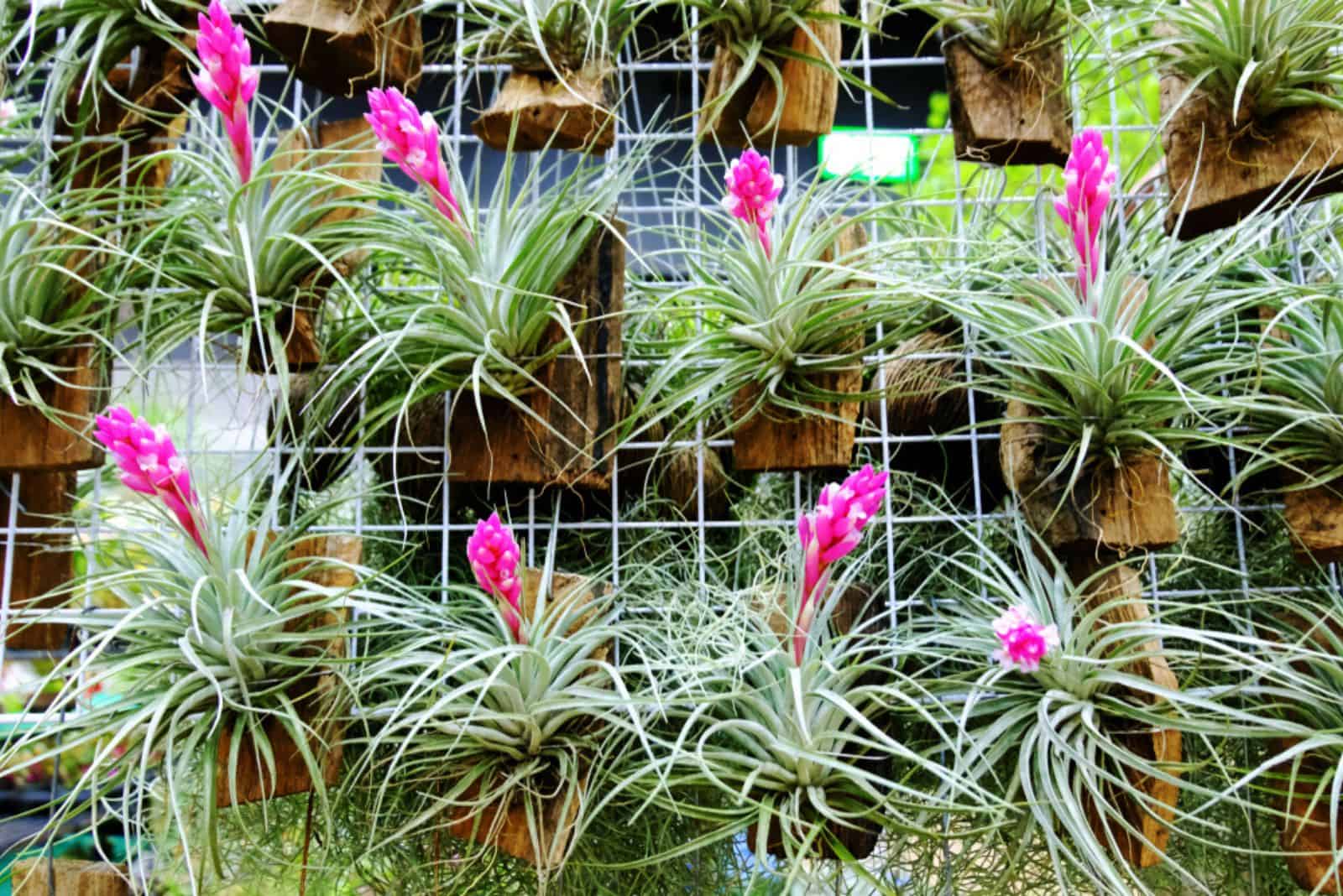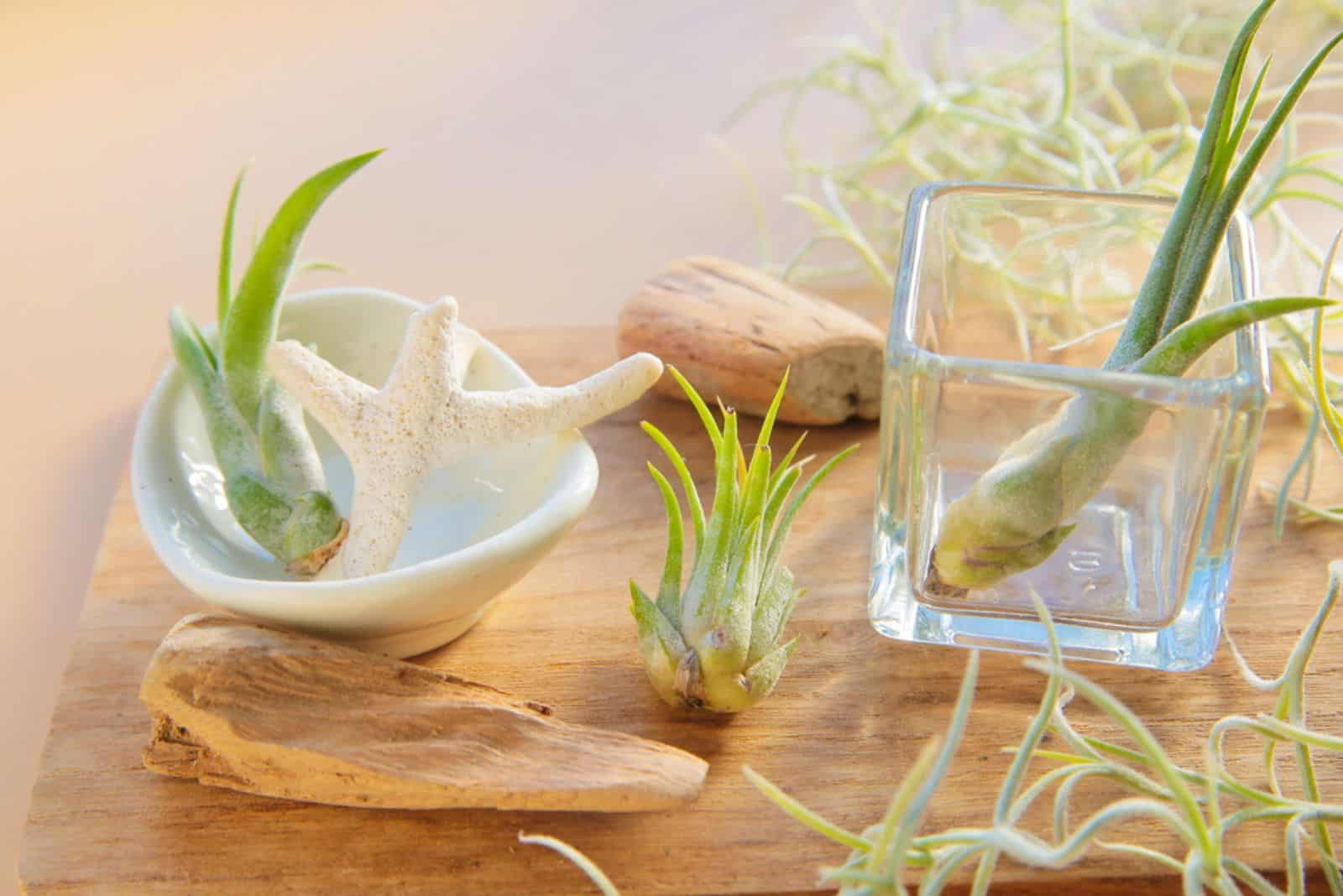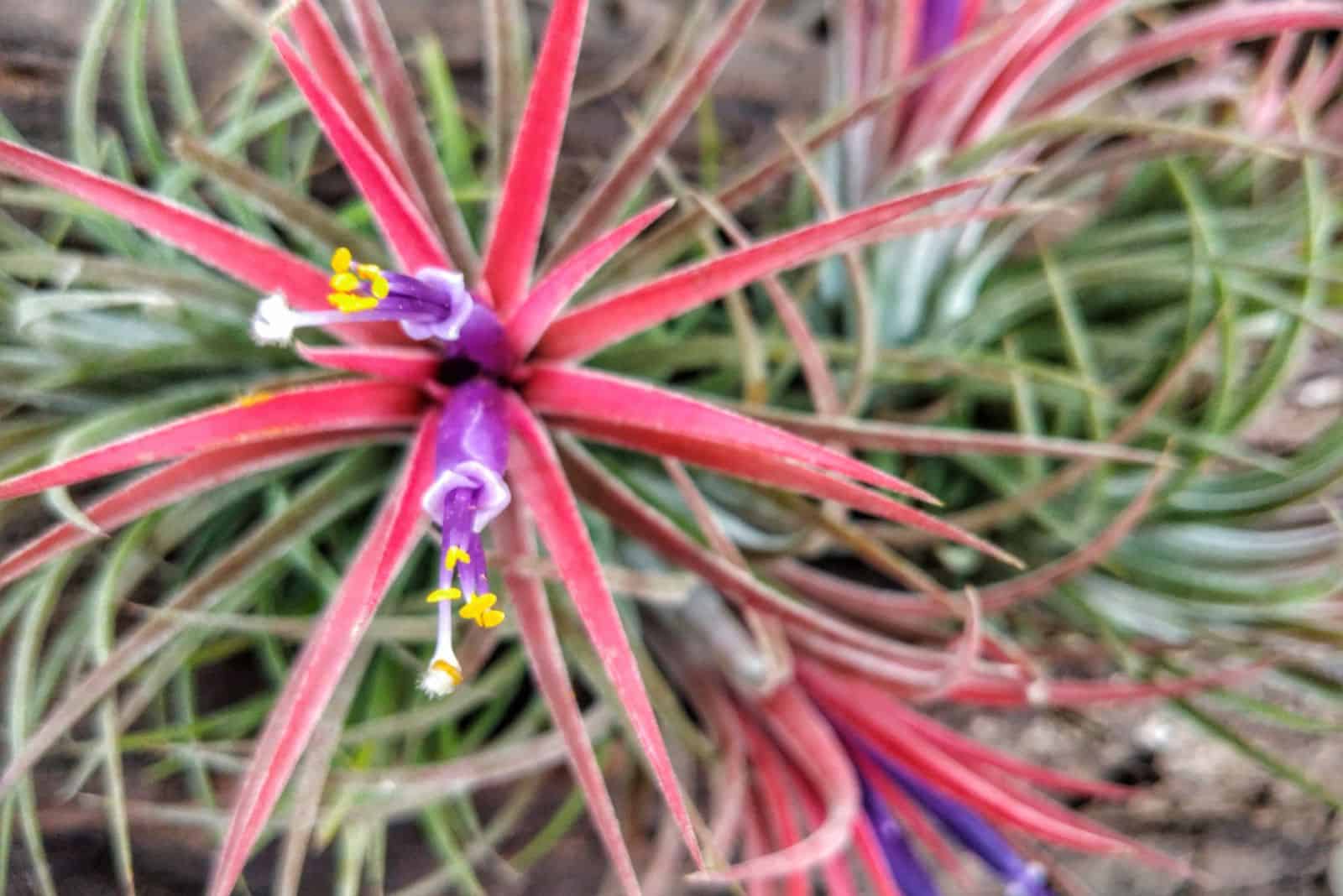Air plants, also known as Tillandsia, are unique-looking plants with unusual growth habits. These plants are epiphytes, which means that they grow on other plants and objects; thus, they don’t need soil for their growth and development.
These plants are often added to gardens, but they can also be grown indoors and are ideal for terrariums. With their long, grass-like leaves, these plants actually look like spider plants. So, if you are a fan of those, then you are definitely going to love the Tillandsia!
If you are considering adding an air plant to your plant collection, you’ll probably be wondering: how long do air plants live? Since these are not your typical houseplants, their lifecycle also differs.
Keep reading to find out more about air plant lifespan and how to keep these lovely plants happy and healthy.
Air Plant Lifespan
Tillandsias are perennial plants that belong to the large genus called the Bromeliaceae family. The air plant life cycle differs from regular plants because they are epiphytic. This means that they grow on other plants or they crawl on the surface in their natural habitat.
The usual lifespan of an air plant is 2 to 5 years, though this can vary between different air plant species and the growing conditions provided. If you don’t provide everything that an air plant needs, its lifecycle will significantly decrease.
There are two air plant types: mesic and xeric air plants.
Mesic plants are the ones that have greener leaves and originate from humid regions, which is why they need frequent watering and deep soaking sessions. They also require bright indirect light. However, xeric air plants come from regions with hot climates, so they can endure stronger lighting conditions and drought periods.
When the two are compared, it seems that mesic plants grow much faster than xeric air plants.
Their lifespan is also affected by propagation methods. For instance, if they are grown from seeds, it will take about 3 years for them to grow into smaller plants. From there, it will take about 3 to 5 years until they mature.
However, if your plant was propagated by offsets, then baby air plants will need about 2 to 3 years to mature.
The air plant blooms only once during its lifetime, and produces lovely violet flowers. The blooming begins once the flower stalk has appeared. A blooming air plant will start producing new pups — air plant pups or offsets can be used for propagation after air plants die. Simply take these pups from a mother plant to start a new air plant growth cycle.
If you don’t use these pups for propagation, they will form clusters called tillandsia balls.
Signs Of An Air Plant Dying
It is rather unfortunate to see your lovely air plant dying. But how can you tell if the plant is close to death?
Well, there are some telltale signs that your plant is weakening and dying. The first sign is the air plant’s leaves — if they are drying, curling, or wrinkling, then there is something wrong with your plant.
Then you can look at the base of the plant — if the base is brown or black, it means that the core is rotting.
Now, what could possibly cause your plant to deteriorate?
Let’s look at some causes.
Reasons Your Air Plant Is Dying
There can be several reasons your air plant is dying. First of all, you should track back and remember when you got it — it could simply be that your plant has reached the end of its lifecycle.
However, if you have just got a new plant and it’s showing signs of dying, then the issue is probably inadequate plant care.
The most common issue that affects air plants is overwatering. If you give it more than enough water, the plant will begin to rot. On the other hand, if you don’t give your plant enough water, then the leaves will dry and curl.
The next thing is incorrect lighting. If you expose these plants to direct sunlight for too long, they will most likely get sunburned. You will end up with a plant that has bleached leaves and crispy leaf tips.
Air plants are also susceptible to pests. Spider mites, mealybugs, and scales are the most frequent air plant visitors. If you spot any of those, you can simply pick them off by hand. However, if they have spread, then you should use horticultural oils or pesticides.
If you want to prevent this from happening, all you have to do is follow the proper air plant care guide!
Air Plant Care Guide
If this is your first time growing air plants, then you have come to the right place!
Don’t worry, caring for these unusual plants is relatively easy. All you have to do is mist them from time to time and make sure that they have plenty of indirect bright light and air circulation.
Let’s discuss this in more detail.
Light Requirements
We must take into account the natural environment of the air plant while considering the ideal light conditions for it. The epiphytic classification of bromeliad plants refers to their attachment to other trees.
What exactly does this mean in terms of light? These plants are not exposed to direct sunlight in their natural habitat because of the enormous trees’ dense foliage, which shields them from sunlight in subtropical regions.
Find a spot for your plant where it can receive bright light that is similar to its natural habitat — it must be in indirect sunlight because direct light can harm the plant.
Air plants are typically cultivated indoors on window sills, so if you choose to put them there, there are some things to take into account.
First off, because these plants like bright light, you should keep them away from windows that face north because those windows don’t get enough light.
Second, although direct sunlight may harm them, they benefit from the early sun. I don’t advise placing your plant close to south-facing windows because they get direct sunlight in the mornings and throughout the day.
Finally, windows that face west or east will give your air plant intense light in the morning and indirect light all day, making them the finest choices.
Water & Humidity Requirements
All plants require water to survive. Since they don’t really use their roots to absorb water, it is considerably easier to irrigate them. Instead, the trichomes found on the surface of the leaves of air plants, which resemble hairs, are what really absorb moisture from the surrounding air.
Due to the high humidity in their natural environment, they don’t have to work hard to obtain extra moisture, which is why they don’t have many of these structures.
In more arid areas where water is scarce, the plant’s surface is covered in trichomes. These microscopic structures are what give these plants their distinctive silvery appearance.
This is why misting your plants every other day is necessary if you keep them in open terrariums. Simply get a spray bottle and spray some water on them.
Because water cannot leave the glass when plants are cultivated in closed containers, less frequent spraying is necessary. In extreme circumstances, too much moisture might cause rotting.
In order to guarantee that these plants receive enough moisture, you need to water them directly if your region is dry. To do this, submerge the entire plant (or the bases) in tap water once or twice each week, or soak them for a few hours once a week. Don’t use distilled water, as it contains chemicals that might damage your plant.
Shake off the extra water because it can cause rotting.
Temperature Requirements
Air plants like warm temperatures. The ideal temperature for air plants is between 70 to 85 degrees Fahrenheit, although there are some varieties, like the Tillandsia bulbosa, that can endure lower temperatures.
I would also suggest that you keep your air plants away from cold drafts and vents, as well as from heat sources like fireplaces and radiators. These plants don’t like temperature fluctuations.
Fertilizer Requirements
Since these plants don’t need soil to grow, fertilizers are not necessary for their development. These plants are usually placed or planted on objects like stones, twigs, shells, and so on, and you can put them in terrariums as well.
However, if you stumble upon some Tillandsia fertilizer, you don’t have to return it. During the plant’s growing season, you can spray some of this plant food on it once or twice a month, or even soak it in water that has fertilizer added.
Frequent feeding, however, can be fatal and detrimental.
Repotting
These plants are excellent because you never need to repot them.
If, however, you have just redecorated your room and the plants’ present container does not go with the style, you can change it.
There are several options for potting, but glass terrariums are the most popular. You can always use some gorgeous rocks, stones, or even pieces of driftwood to showcase this plant if you wish.
The Tillandsia can also be grown in a pot; just place the plant inside the pot and fill it with some small stones or bark.
Propagation
There are a few methods you can use to multiply Tillandsia species to expand your air plant collection. These plants are pretty simple to propagate. They are propagated by sowing the seeds or collecting the pups from the parent plant.
Here is how you do it.
Sowing The Seeds
Step 1. Remove the seeds from the seed pods and, if they are brown, soak them for a couple of weeks in a container of lukewarm water. Puncture a few holes in the lid before sealing the container. You don’t need to soak the seeds if they come with green nubbins already attached.
Pro tip: To promote air circulation, open the lid every couple of days.
Step 2. Separate the seeds carefully.
Step 3. Spread the seeds out on a growing medium such as sphagnum moss, jute fabric, velcro sheet, etc. The substance must retain moisture to support the seeds’ continued growth and development, but it must not become overly wet since this might cause rotting.
Step 4. Put the seeds in a well-lit area and mist them whenever they start to feel dry. In order to prevent mold from forming on the growing media, always let them dry out in between waterings.
Step 5. Move the seeds to a new medium and spray them less regularly if you see that the substrate has turned moldy. The first couple of years will see moderate growth, but after that, it will start growing quickly.
Propagating By Offsets
Step 1. Pick a healthy plant that you want to duplicate, take it out of its current place, and soak it in water until it is completely moist.
Step 2. Take the plant out of the water once it’s hydrated and shake off any excess.
Step 3. Spread the leaves out around the plant’s base until you can see the young pups. Place the plant on a clean, dry sheet.
Step 4. Separate the pups and take them out of the terrarium of the mother plant (or wherever you keep it).
Step 5. Place the pups in a fresh terrarium, put them in a well-lit area, and spray them frequently. Your pups won’t become established air plants for up to 4 years, so wait patiently!
Pruning & Cleaning
The great thing about these plants is that you don’t need to trim or clean them. In fact, whenever you spray water on them or soak them in the water, they get cleaned.
You might want to get rid of leaves that are damaged, though this rarely occurs.
The Best Tillandsia Varieties
If you are a plant lover that has stumbled upon these unique-looking air plants, I am sure that you will want to add some to your collection. Therefore, I have gathered some of the best air plants that you can grow, though there are many more species that can be cultivated indoors.
These are my top choices:
Tillandsia Ionantha
Although it is a member of the Tillandsia genus, this variant is very different from the ones we are familiar with. The foliage of this grass-like variation might be grayish, fire-red, or blue-green, depending on the cultivar.
Tillandsia Bulbosa Guatemala
One of the cultivars we’re all used to seeing is this diminutive Guatemalan option, which features tillandsias’ distinctive serpentine, green leaves.
This plant is a lovely addition to your indoor garden because of its spiky leaves and crimson blossoms.
Tillandsia Caput Medusae
Due to its sharp, snake-like leaves, this plant actually looks like Medusa’s head! Normally green, the foliage occasionally has purple edges close to the root. Additionally, if it is grown in a dry area, its abundant trichomes may give it an alluring silvery aspect.
You shouldn’t be startled if you see bright cherry red and yellow parts with violet and white blossoms, because it produces tubular flowers in a variety of colors.
Tillandsia Bulbosa Belize
Similarly to the Guatemalan cultivar, this cultivar has twisted, pointed leaves, but they are much larger.
Normally green, the leaves can occasionally become bright red as the plant prepares to bloom and produce purple flowers.
Tillandsia Usneoides
The fast-growing Tillandsia usneoides, also known as Spanish moss, is an epiphyte indigenous to Mexico and parts of Central, South, and Southeast America. The extent of this moss’s long, draping fronds ranges from 8 to 10 feet.
Spanish moss was formerly harvested for use in mattresses, the furniture business, automobile seats, homes, and as insulation. The majority of its uses include mulch and floral arrangements, and it’s also occasionally used as packaging material today.
To Sum Up
Now that you know all about the air plant lifespan and how to take care of one, I am sure that you will be adding air plants to your collection as soon as possible. They are quite lovely and have minimum requirements — I mean, you won’t even have to deal with finding the perfect soil mixture or adding fertilizers.
Simply make sure that you give them enough water and plenty of bright light. Also, don’t forget that they need proper air circulation for growth and development (they aren’t called air plants for no reason).
Propagating them is also quite easy, so if you are a beginner gardener, I would suggest that you start practicing propagation with air plants.
That’s all, I hope this article was helpful.
Until next time!

